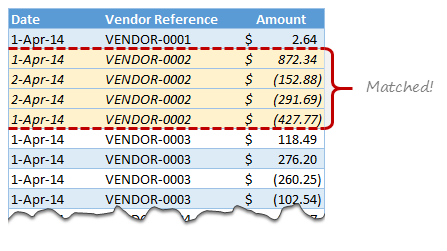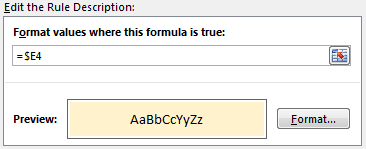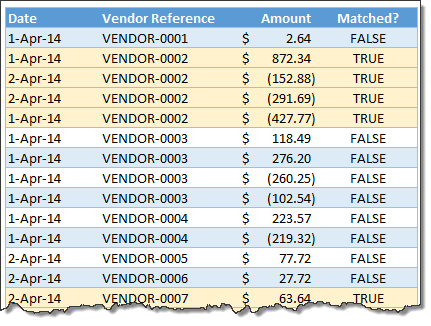Imagine you are the head of Accounts Receivable department at a large company. Drab, I know, But humor me and imagine.
Now, every month you get a transaction report like this:

And you want to know which numbers are matching up.
i.e, if your company gave Vendor-0002 $872.34 on 1st of April, 2014 and your received below payments from them subsequently,
- $427.77 on 1st April
- $152.88 on 2nd April
- $291.69 on 2nd April
Then you consider the account matched since the total received is same as total payable.(427.77 + 152.88 + 291.69 = 872.34).

Manually identifying all such matching transactions can be tedious, boring & error-prone.
This is where formulas come handy.
Using simple Excel formulas, we can identify all matching transactions, highlight them using conditional formatting so that you can chase the vendors with an outstanding.
Note: thanks to Kirstin whose email question prompted me to write this article.
Using formulas to match up (reconcile) accounting transactions
Step 1: Lets take a look at the data
This is how our AR (Accounts Receivable) data looks above (very first image in this post).
For the sake of simplicity I have set up this data as an Excel table.
Step 2: Write the formula
Here is the criteria for matching.
- If the total amounts (paid & received) corresponding to a vendor is zero, we consider it matched.
- Else not.
Add an extra column to the table and write this formula.
=ROUND(SUMIFS([Amount],[Vendor Reference],[@[Vendor Reference]]),2)=0
What this formula does:
It gives TRUE if a particular vendor’s amounts to total to ZERO
else FALSE
How it works?
The SUMIFS formula sums up all the numbers for the vendor name in current row [@[Vendor Reference]]
The ROUND formula rounds it to 2 digit precision. We need to use this because of a floating point error in Excel (that returns extremely small values when the result should be zero).
Related: How to use structural references in Excel
Step 3: Fill down the formula
Fortunately, you don’t have to do this step. Excel automatically fills the formula down as we are using tables. Yay!
Step 4: Highlight matched rows using conditional formatting.
Make a note of the column where TRUE / FALSE values are calculated. In my set-up, it is column E.
Select the entire table. Go to conditional formatting > new rule from home ribbon.
Set up a rule like this:

Note the mixed reference style $E4. This ensures that for highlighting all columns, Excel checks only column E.
That is all. You have now matched all the paid-up transactions. Time to flex your muscles, put-up your legs on the desk and call those other people who did not pay yet.

Download example workbook
Click here to download example workbook & practice. Examine formulas & conditional formatting to learn more.
How do you reconcile / match-up transactions?
I will be honest. I have never been the head of accounts receivable department. Even in my own household, I do not handle receivables. My wife takes care of that. I handle payables (ie credit card bills, shopping expenses and other such things).
But I often use formulas to reconcile my bank statement.
What about you? Do you use formulas to match transactions. What techniques you rely on? Please share your tips & ideas using comments.
Bonus homework
Assuming we have data like above, what formula answers the question:
How many vendors have their transactions matched?
Post your formulas in comments.


















15 Responses to “Modeling Interest During Construction (IDC) – Excel Project Finance”
Thanks again for a very helpful post.
I had a similar problem when trying to model a balance sheet and profit and loss projection. The problem was that interest expense (in P&L) was dependent on a cash shortfall (in BS) which had to be funded. The cash shortfall depended on how much interest was paid, so the mutual dependency made a circular reference.
I addressed it with a macro that calculated interest outside of the P&L, then pasted the calculated amount into the P&L as a value. The model was out of balance, but by repeating the pasting and calculating loop the imbalance reduced to zero. It was a bit messy, and had to be repeated every time a line changed - but it worked.
If I have to do it again I'll read this article again first and see if it can be done more elegantly.
Hi,
The use of a circular reference can be avoided in this case. Just make use of the geometric sum to calculate the interest required. I’ll walk through the example from the spreadsheet.
First calculate the cash needed each year without the interest expense. So you year 1 you need 55 Mn, year 2 105 Mn, and 190 Mn for year 3. The total amount to borrow for year 1 is then (50 Mn)/(1-interest_rate) = (50)/(1-0.1). For years 2 and subsequent the amount borrowed is the cash needed in that year plus the interest_rate times the amount already borrowed. For year 2 (105 + interest_rate * sum(previous debt raised))/(1-interest_rate)=(105+0.1*61.1)/(1-0.1).
This process avoids the need for a circular reference, and makes the calculation more stable.
Thanks,
Tristan
The question is for the year 1 in your case, the amount works out to 45 mn. However in the year 2 you have applied the loan amount as 61.1 mn.
Am I missing something ! Please help !
very helpful information!!!
using circular references and to make model more stable we can use combination of "IF" and "ISERROR" functions. i.e
=if(iserror(formula1),"",(formula1))
this formula will return blank value if there is any error otherwise give the result required.
I usually use this in my models and it makes them very stable......
🙂 🙂 🙂
@Terry: Thats right. Exactly same problem is seen in Interest - Cash cycle in P&L and Cash Flow statement as well. In our trainings on financial modeling in excel, we demonstrate using both the circular loops as well as the macros to take care of this problem. Circular loops have their own pitfalls. If the model enters into a state of error, the error percolates!
@Tristan: Thanks for pointing out. I agree with you that if circular loops can be avoided, they should be avoided.
@Yogesh: This is one way of avoiding the problem. Although circular loops have another problem that they make your sheet slower. Each time, there is a change in the sheet, all the calculations are redone. So if they can be avoided, they should be avoided.
Please note that this was an example (a large one indeed) and I didn't have space to speak about the pitfalls of this approach! I just wanted to illustrate an approach and am glad that some of you found it useful!
I think while posting, there is an error in the images! The last image should be flipped with the one that is posted in step VII!
I think you can try the following simple solution given by Microsoft itself to make the circular works:
Windows: Excel Options -> Formulas -> Put a tick on "Enable iterative calculation"
Mac: Excel -> Preference -> Calculation ->Put a tick on "Limit iteration"
You can change the maximum number of calculation iterations as well as the maximum changes which iteration stops for goal seeking or for resolving circular references based on the number you type in the maximum change box.
Thank you.
Hey All
I heard that we can take care of the circularity with the help of macro for IDC. Can anybody help on the steps to construct the macro for the same.
Regards
Vinay
Hi Vinay,
If you look closely, you are essentially copying the values from the interest calculation to the IDC in project cost.
Basically you can record a macro, that takes the values from interest and pastes special the values in IDC row in project cost.
Then you can run that recorded code in a for loop.
Hope this helps.
Thanks Param for reply.
But before calculating interest, i need to provide for Upfront Equity and Equity, which are essentially part of total project cost. Hence, i need to put in Upfront Equity and Equity to calculate the IDC which is again hitting the total project cost.
Bit of confused on how to remove this circular reference.
Regards
Vinay
Wow, this was a brilliantly simple post. I was looking online for a while before I found this page. Never seen this been explained so beautifully yet so crisply before. Thanks for saving my ass at work! (i'm relatively new to finance + modeling)
I'm not sure why but this web site is loading very slow for
me. Is anyone else having this issue or is it a problem on my end?
I'll check back later and see if the problem still exists.
[…] Project Finance Modeling using Excel – Part 1 & Part 2 […]
I have been reading your blog since my college days. Today, I'm writing just to say thanks.
We have calculated Financial Rate of return of a hydropower projects, and the observer has raised an observation regarding Total Project cost with IDC Rs. 8616.01 million (PKR) and with-out IDC 8352.46 million (PKR). How does the Financial nalysis be calculated on the basis of with-out IDC Or With IDC?????
Please helpf. if possible to spare some time.